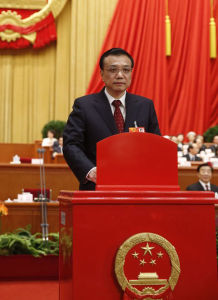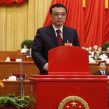
Policy Reform Measures Highlight Potential for Transformation
Publication: China Brief Volume: 13 Issue: 7
By:

In the next five years, China will implement a series of transformative public sector reforms due to the convergence of several factors over the past year that have made China ripe for change. Most obvious among them is the fact that the party leadership chosen in 2012 is unusually united around Xi Jinping, in stark contrast to the factional divisions that characterized the previous leadership (“China’s New Leaders to Strengthen the Party-State,” China Brief, November 30, 2012). Moreover, since Xi and premier Li Keqiang have sat on the Politburo for only five years, they are less encrusted in guanxi than previous leaders. Another factor is that in recent years, distinctive advocacy coalitions have arisen in the country among public policy experts that are unusually vocal and well-informed. Finally, China is in a stage of development where it “enjoys” a constant stream of focusing events—the Bo Xilai scandal, elite corruption, the Beijing air pollution crisis and the Wenzhou high-speed rail crash stand out as a notable few. The Chinese Communist Party’s (CCP) unfulfilled 2004 promise to transform itself from a ruling party to a governing party in order to restore its legitimacy requires an effective government that can analyze, formulate, enact, implement, monitor and revise new public policies. In short, the policy gridlock of the 2002 to 2012 period should be disappearing in favor of an emergent period of substantive reform.
The National People’s Congress of 2013 provided a first glimpse of the sort of public sector reforms that might emerge in the next ten years. Two clear themes emerged: building “top-level design” institutions in Beijing to oversee macro-level governance; and igniting local government initiative through fiscal and regulatory reforms.
Top-Level Design
The notion of “top-level design” (dingceng sheji) to manage reforms is an idea that migrated from the systems engineering and military sectors in the early 2000s to more general public sector reform discussions in the late 2000s. During retrospective analyses of 30 years of reform in 2008, the term was first used as a template for the next 30 years of reforms (Outlook Weekly, November 1, 2010). The party then espoused the term in the communiqué from its 2010 plenum. The 12th Five Year Plan announced in 2011 promised to “pay more attention to the reform of top-level design and overall planning, make clear reform priorities and key tasks, and deepen experiments in comprehensive integrated reforms” [1].
Put simply, it meant that incremental reforms and bargaining over implementation were out. There would be less micromanaging and more macro-managing (jian weiguan, zhong hongguan). China would seek to overcome the “fragmented authoritarianism” that characterized policymaking since reforms began in favor of a more centralized developmental state. New integrated ministries will deliver national templates to create a coherent public policies. This means a premium will be placed on creating bureaucracies with a high degree of professionalism and vision.
One of the first initiatives of this new drive was the creation of several new bureaucratic organizations during the 2013 NPC (The number of cabinet-level ministries and commissions is now half of what it was in 1982 as a result of government efforts to streamline policymaking). The most anticipated change was the folding of the regulatory arm of the Ministry of Railways into the Ministry of Transportation and the creation of a new commercial entity, the China Railway Corporation, to run the country’s 98,000 kilometer-long rail system. China’s railways had become an independent kingdom of power and corruption in Chinese politics, leading to the sacking of railways minister Liu Zhijun for corruption in 2011.
The creation of the new company will end that kingdom. It also presages a long battle over financing. The new company was put under the ownership of the Ministry of Finance, suggesting it will not be expected to make money anytime soon. To become a viable commercial entity, it will have to raise ticket prices. The new company’s deputy chief engineer caused a stir by saying rail tickets eventually would cost more than plane tickets on many routes (Global Times, March 20). The experiences of other developing countries suggest that debates on eliminating subsidies for cheap commodities—bread, fuel, electricity or train tickets—often cause social unrest. At least now, however, there are the makings of a rationally-run national rail network.
The need for “top-level design” also has been increasingly apparent in China’s numerous territorial disputes in the East and South China Seas, where four different agencies in addition to the navy carry out various types of official maritime enforcement duties. The new National Oceanic Administration brings those four agencies under one roof. This will not only lead to “top-level design” in Beijing’s foreign policy, but also the potential for its application to China’s policy toward the East Asian region. The creation of a single counterpart agency with which regional governments can discuss codes of conduct gives foreign governments a clear interlocutor, probably militating the frictions caused by uncoordinated Chinese actions and (“Taming the Five Dragons?” China Brief, March 28).
The one new agency that did not come off well was the new super-agency for media management, the State General Administration of Press, Publications, Radio, Film and Television. The initial announcement gave the agency a 14-character long name in Chinese, which attracted widespread criticism on the internet because it symbolized the inability of the various interests to agree on a shortened form as well as policy more broadly (Xinhua, March 11). A 10-character alternative was hastily rolled out, which only weakened any belief that “top-level design” would be forthcoming in the media field. Given the close horizontal linkages between these interests and party propaganda organs, the reform here is likely to be slower.
The threats to top-level design posed by such institutional interests was noted explicitly by Wang Yang, the innovative former party secretary of Guangdong province who was elevated to vice premier after being passed over for Politburo Standing Committee seat last year. Putting such a heavy hitter in a vice premiership suggests a belief that the government is becoming more important compared to the Party, at least in day-to-day governance decisions. Overcoming “institutional obstacles” to development would be his main focus, he said “If the reforms 30 years ago solved the issue of ideology, now we have come to the issue of interests. Reform is like cutting one’s own flesh, so we need great determination” (Xinhua, March 17).
New Premier Li Keqiang also promised a “self-imposed revolution” of government reform, continuing a regulatory streamlining process begun in 2001 and carried out largely under his predecessor, Wen Jiabao. China is not ready for the mandatory sun-setting of regulations adopted by many OECD countries, but it recognizes that red tape has become a source of rent-seeking and property rights infringements throughout the country.
Alongside this came promises of a new nationally-streamlined system of financial and real asset registration that would bolster both tax and regulatory compliance as well as anti-corruption efforts (Xinhua, March 15). In both these respects, the Xi Jinping leadership is responding to increasingly vocal constituencies within the business community who find themselves at a competitive disadvantage when they try to navigate and comply with the country’s patchwork of financial and tax regulations (Workers’ Daily, January 27).
Fiscal and Regulatory Reform
Fiscal and regulatory reforms adopted at the NPC also gave insights into emerging public policy issues that will be key in the next ten years. The abolition of the State Family Planning Commission was announced in Stalin-esque style with the proclamation that it had overseen triumphantly the abortion of 336 million fetuses since 1971. This dispassionate declaration was the most elegant reminder of the need for new management. The new National Health and Family Planning Commission will integrate family planning into healthcare, while the National Development and Reform Commission (NDRC) will work on macro-level issues.
The abolition of the “one-child policy” agency was closely linked to another reform touted at the NPC: new local powers of taxation—something outgoing premier Wen suggested in his government work report. A month before the NPC convened, the International Monetary Fund issued a report predicting that China would reach the “Lewis Turning Point” sometime between 2020 and 2050, wherein the migration of surplus agricultural labor into industry and services ends and economic growth slows. Coupled with declining fertility in the cities and a rapidly aging population, China’s ratio of working to non-working people would rise quickly [2]. One of the obvious policy implications is that local governments will be faced with mounting costs of old age care just as economic growth slows, raising the specter of local fiscal crises.
Broaching the question of local taxation powers always has been politically risky in China, because of the unitary nature of the state and its ideology. Local governments receive fixed allotments of tax-sharing revenues but these lag far behind their responsibilities. In 2011, local governments accounted for 85 percent of government spending in China but received only 52 percent of tax revenues. The gap is accounted for through a variety of means: “special transfers” that local governments bargain for from Beijing; off-budget borrowing through local investment companies—as one State Council researcher put it, “most of the debt exists in a covert state”—and land sales (China Daily, March 13; “Local Government Financing Growing Increasingly Precarious,” China Brief, May 11, 2012).
The system basically has given local governments an incentive to do everything except improve their local revenue raising capacity, according to a study commissioned by the China Academy of Public Finance and Public Policy [3]. New taxes like environmental taxes and resource taxes are being considered, alongside a larger share of income and business taxes and a share in property transfer taxes. The new finance minister, Lou Jiwei, played an instrumental role in shaping the 1994 tax reform that introduced formal tax-sharing between the central and local governments.
The second aspect of rebuilding governance at the local level will be a comprehensive urbanization plan due to be rolled out by the NDRC in the second half of 2013. While China always has had urban planning, this will be the first time that the national household registration (hukou) system that ties rural-dwellers to their land will be integrated into a broader national development strategy. With surplus labor in the countryside disappearing, the hukou system makes little sense other than as a means of social control. Local governments will need more urban residents to bolster tax revenues.
The NDRC itself probably emerged as the biggest winner from the various changes announced at the NPC. In addition to gaining control over population and urban planning portfolios, it also took over a new national energy administration. The NDRC is emerging as China’s Ministry of International Trade and Industry (MIT) and with obvious hopes that it can create a national development miracle as did MITI in Japan [4]. The term now being used officially is the “China Dream”. Whatever its nationalist overtones, making the dream come true will depend mainly on prudent public policy and public sector reforms over the next ten years.
Notes:
- Twelfth Five-Year Plan (in Chinese), available online <https://news.sina.com.cn/c/2011-03-17/055622129864.shtml>.
- Mitali Das and Papa N’Diaye, “Chronicle of a Decline Foretold: Has China Reached the Lewis Turning Point?” IMF Working Papers, No. 13/26, January 29, 2013.
- Liu Yongzheng and Zhao Jianmei, “Intergovernmental Fiscal Transfers and Local Tax Efforts: Evidence from Provinces in China,” Journal of Economic Policy Reform, Vol. 14, No. 4, 2011, pp. 295–300.
- The Japanese Ministry of International Trade and Industry (MITI)—best-known for engineering Japan’s rise to economic superpower—was a ministry responsible for setting international trade policy by seeking input from a variety of stakeholders.





